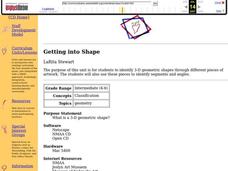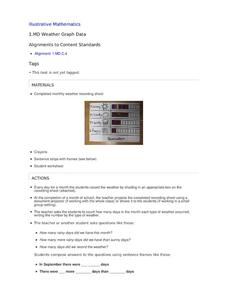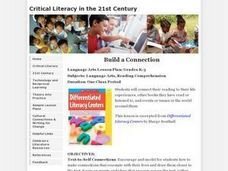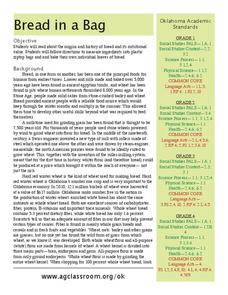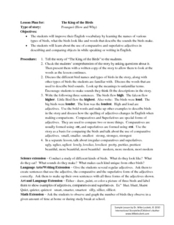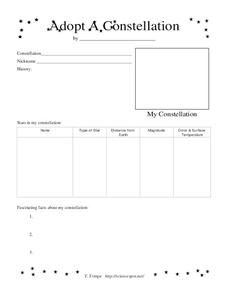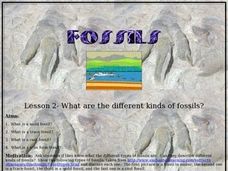Curated OER
Counting Sentences' Words
Explore language arts by completing a worksheet with class. They read the story Owl Moon and discuss the rhythm of the writing and how action verbs are used appropriately. Then complete a writing worksheet which discusses writing...
Curated OER
Getting into Shape
Young scholars identify 3-D geometric shapes through different pieces of artwork. They examine and identify segments and angles. Students act out shapes and create a piece of artwork. Additional cross curriculum activities are listed.
Curated OER
Problem Solving Model
Use a vocabulary chart to introduce math functions. The class defines a list of mathematical vocabulary terms on a worksheet, as well as completes equations and expressions. They examine word problems and practice transcribing them into...
Illustrative Mathematics
Weather Graph Data
Teaching young mathematicians about collecting and analyzing data allows for a variety of fun and engaging activities. Here, children observe the weather every day for a month, recording their observations in the form of a bar graph....
EngageNY
Solution Sets of Two or More Equations (or Inequalities) Joined by “And” or “Or”
English and math have more in common than you think. Make a connection between a compound sentence and a compound inequality with an activity that teaches learners the difference between an "and" and "or" inequality through solutions...
Core Knowledge Foundation
Weather or Not, Seasons Change
Embark on a year long investigation of the seasons with this 10-lesson earth science unit. After being introduced to different types of weather and the tools used to measure it, young scientists perform fun hands-on activities that...
ARKive
Biodiversity and Evolution – Darwin’s Finches
Teens experience natural selection firsthand (or first beak) in an activity that has them act as finches foraging for food. Using different household items to act as different beak styles, your little finches will collect as much...
Curated OER
Rock On!
After five class sessions, young scientists will be able to identify common rock types: igneous, sedimentary, and metamorphic. This plan involves hands-on activities, includes various handouts and worksheets, and requires there to be...
Curated OER
Build a Connection
Learners discuss their personal connections with stories they've read in the past and identify techniques to connect with more stories. They create illustrations, construct task cards, and complete sentence stems based on books they read...
Curated OER
Bread in a Bag
Could the history of bread really be interesting? Yes, it could! An informational text gives scholars wheat production background from 8,000 years ago, discussing different types of bread and the current industry in Oklahoma. Learners...
Curated OER
The King of the Birds vocabulary
Science and language skills come together in The King of the Birds. After reading, discuss the names and types of birds in the story and write given sentences to portray the difference between comparative and superlative adjectives....
Curated OER
Oodles of Noodles
Students investigate non-standard and standard measurement including inches and centimeters. They use different types of noodles as non-standard units of measurement comparing them to inches and centimeters.
Curated OER
Expressive Body Part Identification
Young scholars participate in activities with Mr. Potato Head and Inspector Gadget. During the activity, they must request the body part they want to add to the body. They must state their request in a complete sentence and point to the...
Curated OER
Rocks and Minerals
First graders examine different types of rocks and minerals. They create models of the rocks and minerals they find interesting. They discuss and explain three ways in which the earth changes.
Curated OER
Web-Based Practice
Students explore technology by participating in a word structure activity. In this grammar lesson, students utilize the Writing Center computer software to practice keyboarding while identifying word formations in class. Students...
Curated OER
Is This a House for Hermit Crab?
First graders identify text that uses sequence or other logical order. They identify and interpret how different plants and animals inhabit different kinds of environments and have external features that help them thrive in different...
Curated OER
ADULT ESOL LESSON PLAN--Level 4--Interpersonal Communication
Students examine and practice different types of interpersonal communication. They encounter how to greet people and say good-by in interpreting formal and informal settings (with proper vocabulary).
Curated OER
Plasma 101
Learners examine the definitions and characteristics of plasma. After reading an article, they analyze new technologies to study plasma. In groups, they create a poster on how the different types of plasma work and write letters to their...
Curated OER
Watching the Elections
Students analyze the media products and advertising techniques used in political campaigns. In this elections lesson, students view political debates and then work in groups to find examples of types of advertising techniques used in...
Curated OER
Getting the Message: What Did You Say?
Students listen to and compare the first sentence of the Gettysburg Address spoken in different languages. They also compare frequency readings for each and discuss how the brain interprets spoken words.
Curated OER
Adopt a Constellation
Students adopt a constellation and find detailed information about their constellation. In this constellation lesson plan, students use the web to find information about a constellation of their choice. They identify the history of the...
EngageNY
Solution Sets to Inequalities with Two Variables
What better way to learn graphing inequalities than through discovering your own method! Class members use a discovery approach to finding solutions to inequalities by following steps that lead them through the process and...
Curated OER
The Strength of the Muscular System
Seventh graders investigate the strength of the muscular system. They explore voluntary and involuntary muscle movement and discuss the types of muscles: cardiac or heart, skeletal, and smooth. They visit stations to answer questions...
Curated OER
What are the Different Kinds of Fossils?
Young scholars examine different types of fossils. In this fossil lesson, students investigate the attributes of mold fossils, trace fossils, cast fossils, and true form fossils. Young scholars create their own fossil samples.
Other popular searches
- 4 Types of Sentences
- Four Types of Sentences
- Grammar Types of Sentences
- Different Types of Sentences
- Types of Sentences Games
- 3 Types of Sentences
- Sentences Types
- 4 Sentences Types
- Interrogative Sentence Types
- Identifying Types of Sentences
- Types of Sentences Worksheets
- Types of Sentences (Complex)

